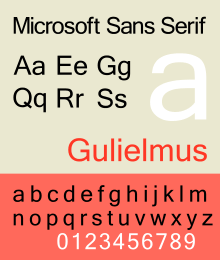MS Sans Serif
 | |
| Category | Sans-serif |
|---|---|
| Classification | Neo-grotesque sans-serif |
| Designer(s) | Microsoft |
| Foundry | Microsoft Typography |
| Date created | 1997 |
| Date released | 1997 |
| Design based on | MS Sans Serif (variation), Helvetica |
| Also known as |
MS Shell Dlg[1] Helv |
| Trademark | Microsoft Sans Serif is either a registered trademark or a trademark of Microsoft Corporation in the United States and other countries. |
MS Sans Serif is a proportional raster font introduced in Windows 1.x as "Helv". MS Sans Serif is very similar in design to Arial and Helvetica. It changed to its current name in Windows 3.1. A TrueType version, Microsoft Sans Serif, was introduced with the release of Windows 2000.
History
MS Sans Serif is the default system font on Windows 3.1, Windows 95, Windows NT 4.0, Windows 98, and Windows ME. Starting from Windows 2000, the default desktop scheme uses Tahoma. MS Sans Serif is available in the font sizes 8, 10, 12, 14, 18, and 24. When changing dpi settings in Windows 95 or later (in Windows 3.1, dpi setting is tied to screen resolution, depending on driver information file), Windows is configured to load a different MS Sans Serif font, historically called the "8514" variant, which adds sizes 23 and 30 points.
Today, the font is still available in all editions of Windows 7 (a Euro symbol was added for the release of Windows 98), and is still used in menus, dialog boxes, etc. The name "Helv" is still used in Windows as a synonym for MS Sans Serif.
Microsoft Sans Serif
Microsoft Sans Serif is a TrueType font that is designed as a vectorized, metric-compatible variant of MS Sans Serif, distributed with Windows 2000 and later (designed by Microsoft). This font also contains most glyphs shipped with any version of Windows until Windows Vista, excluding fonts supporting East Asian ideographs. The PostScript font name is MicrosoftSansSerif.
Despite being a vectorized replacement, there are subtle design changes. For example, the tail in the lowercase "a" is shortened to a vertical stem in Microsoft Sans Serif, the top of the stem on the lowercase "f" curves down instead of horizontally, the hook at the descenders of "y" and "j" are hooked up in Microsoft Sans Serif, the strokes in the middle of digit "8" intersect at a different angle. Capital R, which was designed in the style of original Helvetica in the original MS Sans Serif, is instead a compromise between Helvetica and the straight-diagonal descender in Arial; the descender curves at the top and is a straight diagonal at the bottom.
Version 1.10 of the font includes 1119 glyphs (1209 characters, 26 blocks), supporting Unicode ranges Alphabetic Presentation forms, Arabic, Arabic Presentation forms A-B, Cyrillic, General Punctuation, Greek and Coptic, Hebrew, Latin Extended-A, Latin Extended-B, Latin Extended Additional, Mathematical Operators, Thai. Supported code pages include 1250-1258, Macintosh US Roman, 874, 864, 862, 708. Font is smoothed at 0-6 points, hinted at 7-14 points, hinted and smoothed at 15 and above points. OpenType features includes init, isol, medi, fina, liga for default Arabic script.
Version 1.41 (supplied with Windows XP SP2) includes 2257 glyphs (2301 characters, 28 blocks), which extended Unicode ranges to include Combining Diacritical Marks, Currency Symbols, Cyrillic Supplement, Geometric Shapes, Greek Extended, IPA Extensions, Number Forms, Spacing Modifier Letters. New OpenType scripts include Arabic MAR script. Additional OpenType features includes rlig for Arabic scripts.
Version 5.00 (supplied with Windows Vista and Server 2008) includes 3053 glyphs (2788 characters, 36 blocks), which extended Unicode ranges to include Arabic Supplement, Combining Diacritical Marks Supplement, Combining Half Marks, Latin Extended-C, Latin Extended-D, Phonetic Extensions, Phonetic Extensions Supplement, Specials, Superscripts and Subscripts. New OpenType scripts include Arabic URD (Urdu), Cyrillic (default), Hebrew (default), Latin (default, Romanian), Thai (default). Additional OpenType features includes ccmp, mark, mkmk for Arabic scripts; locl for Arabic URD (Urdu) script; mark, mkmk for default Cyrillic; dlig, ccmp, mark for default Hebrew; ccmp, mark, mkmk for Latin scripts; locl for Romanian Latin; ccmp, mark, mkmk for Thai.
The Latin Microsoft Sans Serif glyphs are also used in this font: Kartika. Panosed as Cove, but the ttf font is panosed as sans.
Non-Microsoft operating systems
On October 16, 2007, Apple announced on their website that the next version of Mac OS X v10.5 ("Leopard"), would include Microsoft Sans Serif. Leopard also ships with several other previously Microsoft-only fonts, including Tahoma, Arial Unicode, and Wingdings. MS Sans Serif has been included with all OS X versions since.
OS/2 and its successor eComStation still name the font "Helv".
Retail versions of the font are sold through Ascender Corporation.
Notes
- ↑ MS Shell Dlg is a logical font which maps to the shell system font, usually MS Sans Serif. See Using MS Shell Dlg and MS Shell Dlg 2 on Microsoft Developer Network
External links
| Wikimedia Commons has media related to Microsoft Sans Serif. |